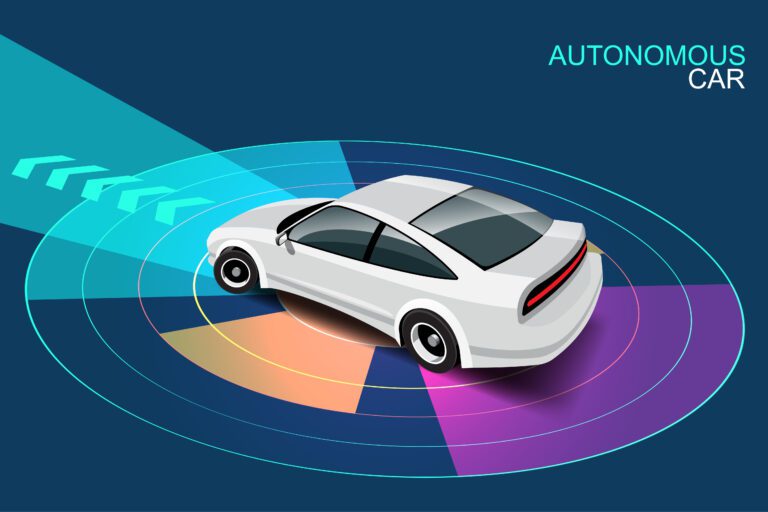Autonomous vehicles, also known as self-driving vehicles, are vehicles that can operate without human intervention. They utilize advanced technologies such as sensors, cameras, and artificial intelligence to perceive their environment, make decisions, and navigate roads. Autonomous vehicles have the potential to revolutionize transportation by improving road safety, increasing efficiency, and providing greater accessibility to mobility.
How Do Autonomous vehicles Work?
Autonomous vehicles rely on a combination of sensors, including radar, lidar, and cameras, to detect and interpret their surroundings. The data collected from these sensors is processed by onboard computers, which use algorithms and machine learning to make decisions and control the car’s movements. The vehicles can analyze road conditions, recognize traffic signs, and navigate complex traffic scenarios, all without human intervention.
The Benefits of Autonomous vehicles
The adoption of Autonomous vehicles offers numerous benefits. One of the key advantages is improved road safety. By eliminating human error, Autonomous vehicles can potentially reduce accidents caused by factors such as distracted driving or fatigue. Moreover, autonomous vehicles can increase transportation efficiency by optimizing traffic flow, reducing congestion, and minimizing fuel consumption.
Additionally, Autonomous vehicles have the potential to provide greater accessibility to transportation for individuals who are unable to drive or people with disabilities. They can enhance mobility options and promote inclusivity in transportation.
Challenges and Concerns Surrounding Autonomous vehicles
While the potential benefits are significant, there are challenges and concerns that need to be addressed. Safety remains a critical consideration, as the technology must be robust enough to handle complex and unpredictable situations on the road. Cyber security is another concern, as autonomous vehicles rely on connectivity and data exchange, making them potentially vulnerable to hacking or unauthorized access.
Ethical considerations also come into play, particularly in situations where the vehicle must make decisions that may impact the safety of occupants or others. Moreover, the deployment of Autonomous vehicles may lead to job displacement in industries that heavily rely on human drivers, necessitating proactive measures to support affected workers.
The Impact of Autonomous vehicles on Society
Autonomous vehicles have the potential to transform society in numerous ways. They can reshape transportation infrastructure, influence urban planning, and change how people live and work. With increased efficiency and reduced traffic congestion, Autonomous vehicles can lead to shorter commuting times and a more sustainable environment. Moreover, they have the potential to revolutionize industries such as logistics, delivery services, and public transportation.
The Future of Autonomous vehicles
The future of Autonomous vehicles holds exciting possibilities. Continued advancements in technology will likely lead to more sophisticate and reliable autonomous systems. Increased connectivity and vehicle-to-vehicle communication will enhance traffic management and coordination. Furthermore, the development of smart cities and infrastructure will create an ecosystem that supports the seamless integration of Autonomous vehicles. However, challenges such as regulatory frameworks, public acceptance, and infrastructure development need to be overcome for the widespread adoption of Autonomous vehicles.
Government Regulations and Policies
Government regulations and policies play a crucial role in shaping the development and deployment of autonomous vehicles. To ensure safety on public roads, governments need to establish guidelines and standards for testing and certification. They must also address liability and insurance requirements to determine who is responsible in case of accidents. Additionally, regulations should cover data collection, privacy protection, and cyber security to safeguard user information. Governments should collaborate with industry stakeholders, researchers, and the public to create a comprehensive regulatory framework that promotes innovation while ensuring the safe and ethical use of autonomous vehicles.
Security and Privacy Considerations
As Autonomous vehicles become more connected and reliant on data, security and privacy considerations become paramount. Protecting Autonomous vehicles from cyber threats and unauthorized access is crucial. Robust cyber security measures, including secure communication protocols and authentication mechanisms, must be implemented. Furthermore, privacy frameworks should govern the collection, storage, and use of personal data collected by Autonomous vehicles. Ensuring the security and privacy of users’ information builds trust and confidence in the technology, fostering wider adoption of Autonomous vehicles.
Autonomous vehicles and the Environment
Autonomous vehicles have the potential to positively impact the environment. By optimizing driving patterns and reducing traffic congestion, they can help minimize fuel consumption and decrease greenhouse gas emissions. Additionally, the integration of autonomous electric vehicles can further contribute to a greener transportation system by reducing reliance on fossil fuels. However, it is important to consider the environmental impact of manufacturing and disposing of autonomous electric vehicles. Adopting sustainable practices, such as using eco-friendly materials and promoting recycling, is essential to ensure that the overall lifecycle of Autonomous vehicles is environmentally responsible.
Ethical Considerations and Decision-Making
Autonomous vehicles raise important ethical considerations, particularly in decision-making situations where there may be conflicts between different outcomes. For example, if a collision is unavoidable, the vehicle must make split-second decisions that prioritize the safety of occupants, pedestrians, and other road users. Establishing ethical frameworks and guidelines for decision-making algorithms is crucial to ensure that Autonomous vehicles act in the best interest of all stakeholders. Public discourse and input from ethicists, policymakers, and the general public are necessary to navigate the complex ethical challenges associated with Autonomous vehicles.
The Role of Artificial Intelligence in Autonomous vehicles
Artificial intelligence (AI) plays a central role in enabling Autonomous vehicles to perceive, reason, and make decisions. AI algorithms analyze data from sensors to identify objects, understand the environment, and predict the behavior of other road users. Machine learning techniques allow Autonomous vehicles to continuously improve their performance through experience and exposure to real-world scenarios. The advancement of AI technologies, such as deep learning and neural networks, enhances the capabilities of Autonomous vehicles, enabling them to handle complex driving situations with greater accuracy and reliability.
Advancements in Autonomous Vehicle Technology
Advancements in technology continue to drive the evolution of Autonomous vehicles. Sensor technologies, such as lidar, radar, and cameras, are becoming more advanced and affordable, allowing for better perception and detection capabilities. Computing power has increased, enabling faster processing and decision-making. Connectivity and communication technologies facilitate vehicle-to-vehicle and vehicle-to-infrastructure interactions, enhancing coordination and safety. Furthermore, software algorithms and machine learning techniques are constantly improving, enabling Autonomous vehicles to adapt to diverse driving conditions. These technological advancements pave the way for safer, more efficient, and intelligent Autonomous vehicles.
Autonomous vehicles and Job Displacement
The rise of Autonomous vehicles has raised concerns about the potential displacement of jobs in industries that heavily rely on human drivers. The automation of transportation services, such as taxis, ride-sharing, and delivery, may lead to a decreased demand for human drivers. However, it is important to approach this issue with a balanced perspective. While some jobs may be affected, the emergence of Autonomous vehicles also creates new employment opportunities. Industries related to autonomous vehicle technology, such as software development, data analysis, and maintenance, will experience growth. Moreover, the deployment of Autonomous vehicles can lead to improved efficiency and cost savings, which can stimulate economic growth and potentially create new jobs in other sectors.
Conclusion
Autonomous vehicles/vehicles have the potential to revolutionize transportation, offering benefits such as improved safety, increased efficiency, and greater accessibility. However, the widespread adoption of Autonomous vehicles is not without its challenges. Safety, cyber security, ethical considerations, and regulatory frameworks must be addressed to ensure the responsible development and deployment of Autonomous vehicles. Moreover, society needs to prepare for the potential job displacement that may occur as a result of automation. By embracing innovation, fostering collaboration between industries and policymakers, and ensuring a smooth transition for affected workers, we can harness the full potential of Autonomous vehicles while mitigating any negative impacts. The future of Autonomous vehicles holds immense promise, and by addressing these challenges, we can shape a transportation system that is safer, more sustainable, and more inclusive.
Frequently Asked Questions (FAQs)
Q. Are autonomous vehicles completely safe?
A. Autonomous vehicles are designed with safety as a top priority, utilizing advanced technologies to perceive their environment and make informed decisions. However, as with any technology, there is always a risk of unforeseen circumstances or malfunctions. Extensive testing and continuous improvements are being carried out to enhance the safety of autonomous vehicles.
Q. What are the legal implications of autonomous vehicles?
A. The legal landscape surrounding autonomous vehicles is still evolving. Governments are working on developing regulations and policies to address various aspects, including liability in accidents, insurance requirements, and compliance standards. Collaborative efforts between industry stakeholders and policymakers are essential to establish a robust legal framework for autonomous vehicles.
Q. Can autonomous vehicles operate in all weather conditions?
A. Autonomous vehicles are equipped with advanced sensors that enable them to navigate in various weather conditions. However, extreme weather conditions such as heavy rain, snowstorms, or dense fog can pose challenges to the sensors’ functionality. Manufacturers are continuously improving the technology to enhance the performance of autonomous vehicles in adverse weather conditions.
Q. Will autonomous vehicles replace traditional vehicles completely?
A. While autonomous vehicles have the potential to transform transportation, it is unlikely that traditional vehicles will be completely replaced in the near future. The adoption of autonomous vehicles is expected to happen gradually, and different types of vehicles will coexist depending on specific use cases and preferences.
Q. What about the ethical dilemmas autonomous vehicles may face?
A. Ethical considerations arise when autonomous vehicles encounter situations where they must make split-second decisions that may impact the safety of occupants or others. These dilemmas raise complex questions that need to be addressed through ethical frameworks and public discourse to ensure the responsible and ethical behavior of autonomous vehicles.
Q. What measures are being taken to address cyber security concerns?
A. Cyber security is a critical aspect of autonomous vehicle development. Manufacturers and researchers are investing in robust cyber security measures to protect autonomous vehicles from potential cyber threats. These measures include secure communication protocols, encryption, intrusion detection systems, and regular software updates to address vulnerabilities.
Q. How will autonomous vehicles impact traffic congestion?
A. Autonomous vehicles have the potential to reduce traffic congestion through optimized routing, improved traffic flow, and enhanced coordination between vehicles. With connected autonomous vehicles, real-time data sharing and communication can further enhance traffic management, leading to smoother and more efficient transportation systems.
Q. Can autonomous vehicles be hacked?
A. While the possibility of hacking cannot be completely eliminated, manufacturers are implementing stringent security measures to minimize the risk. By employing robust encryption, authentication protocols, and regular security updates, autonomous vehicles aim to prevent unauthorized access and maintain the integrity of their systems.
Q. Will Autonomous vehicles require a human backup driver?
A. Some Autonomous vehicle systems currently in use require a human backup driver to be present to take control in certain situations. However, advancements in technology are moving toward fully autonomous vehicles that do not require human intervention. The exact requirements may vary depending on local regulations and specific use cases.
Q. What is the timeline for the widespread adoption of autonomous vehicles?
A. The timeline for widespread adoption of autonomous vehicles is uncertain and depends on various factors such as technological advancements, regulatory frameworks, public acceptance, and infrastructure development. While autonomous vehicles are already being tested and deployed in certain areas, achieving full-scale adoption will likely take several years or even decades.
Remember, these FAQs provide general information and may not cover every aspect of Autonomous vehicles/autonomous vehicles. It is recommended to consult authoritative sources and stay updated on the latest developments in autonomous vehicle technology.







